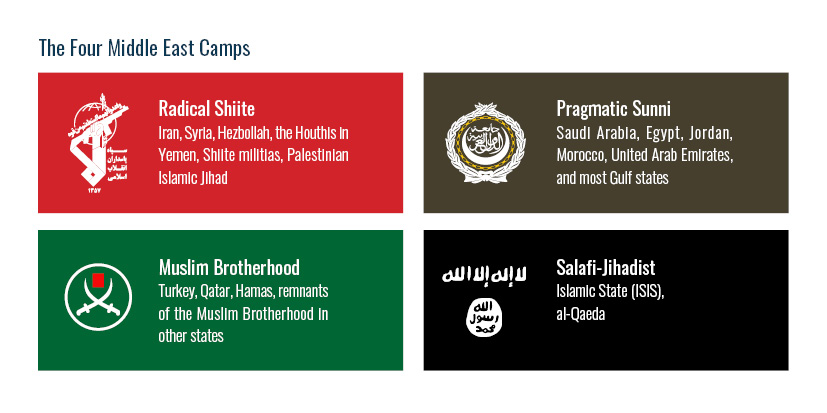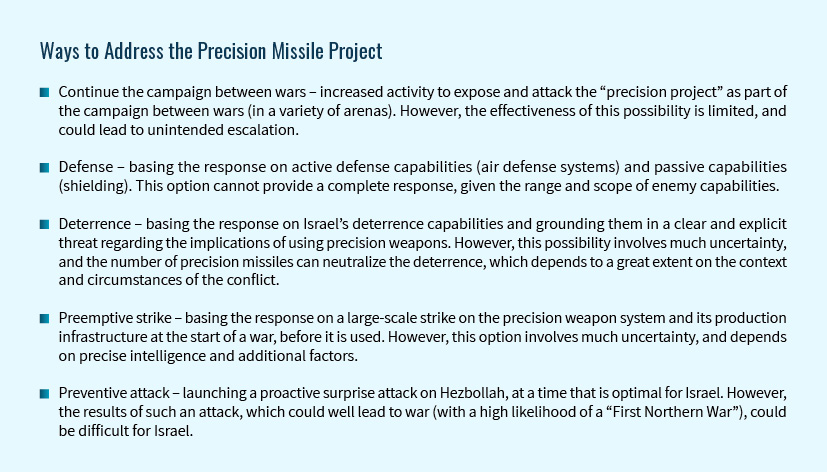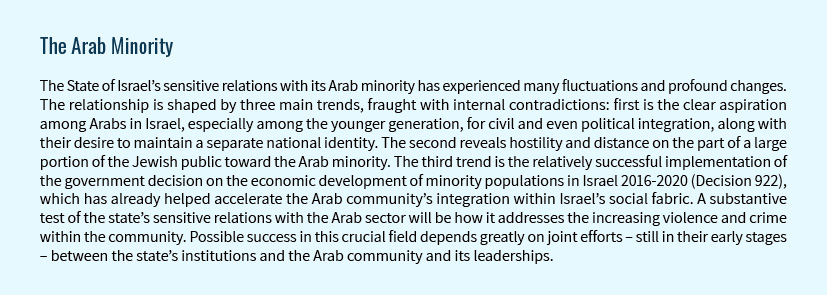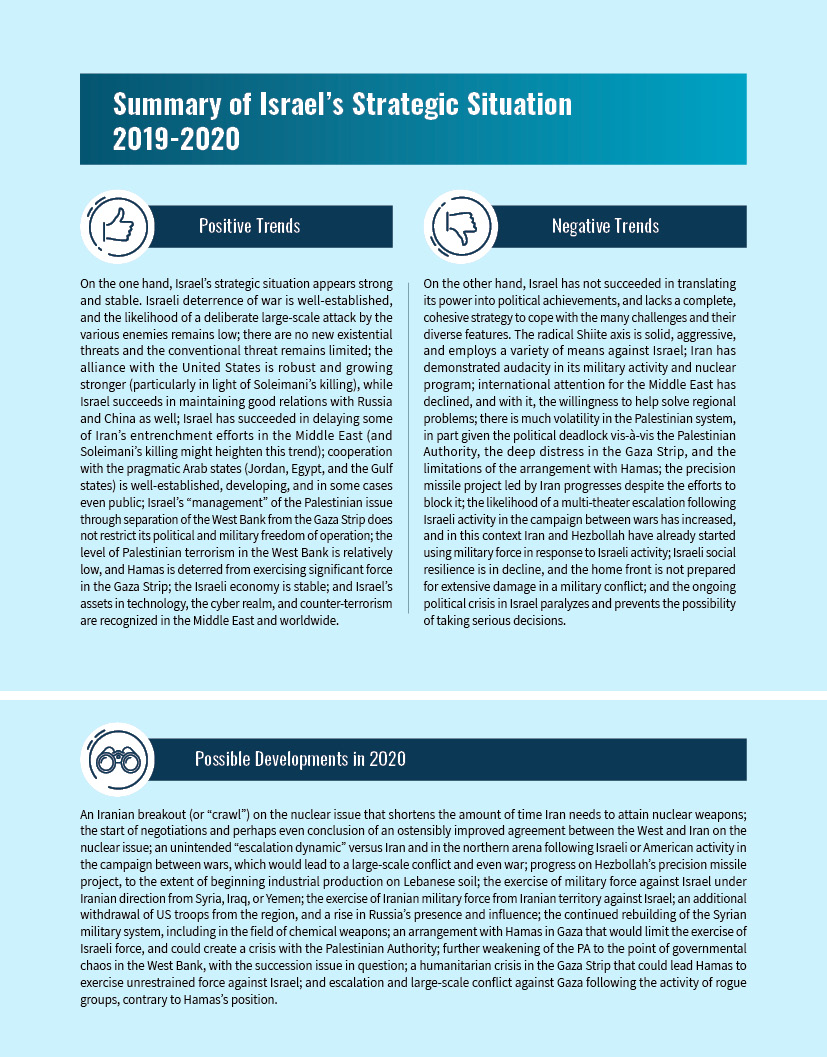Publications
Strategic Survey for Israel 2019-2020, The Institute for National Security Studies, January 2020
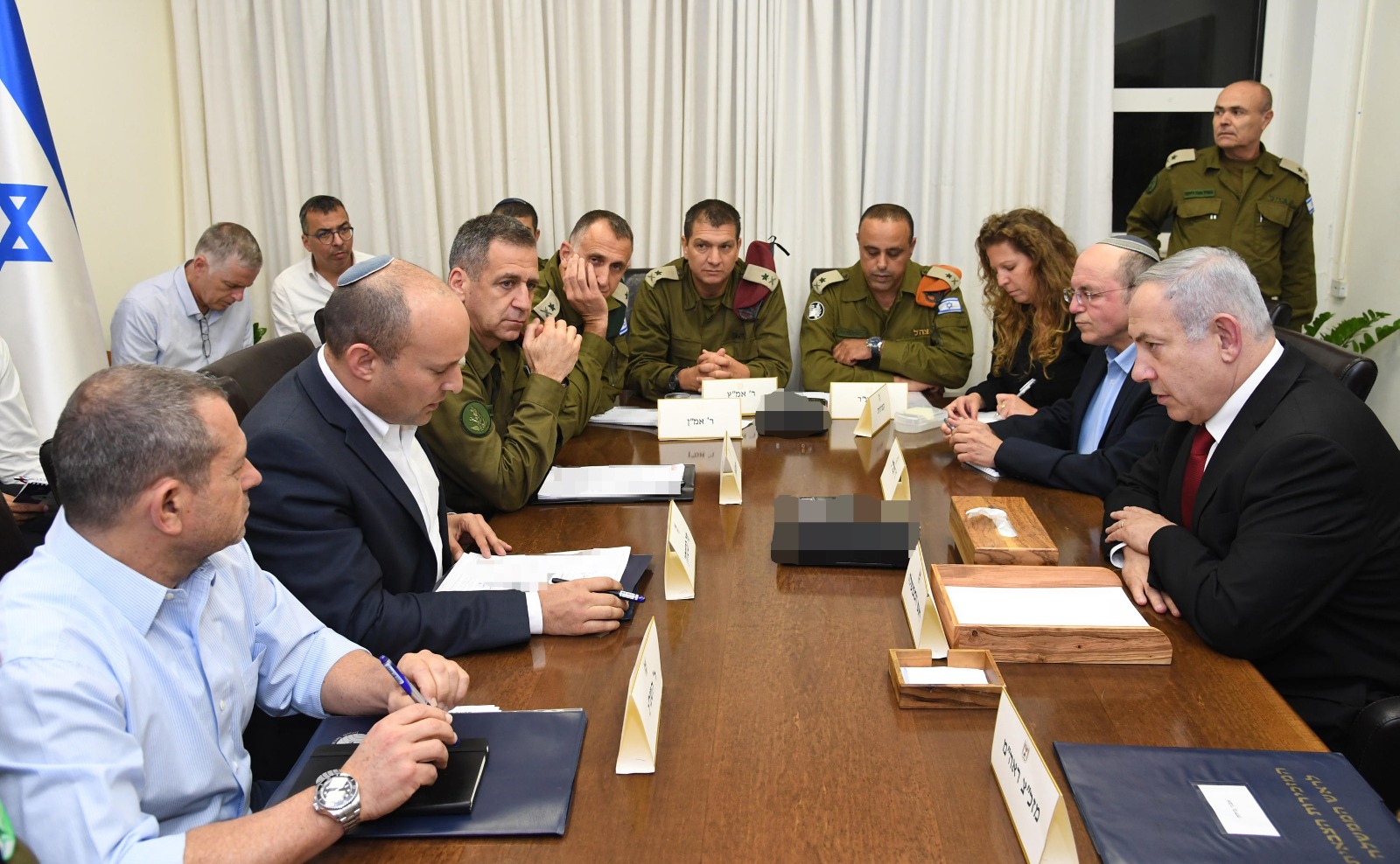
At the core of the strategic assessment for 2020 stands the tension between Israel’s evident strength and its success in various fields, and the possibility that this positive state of affairs will prove temporary and fragile. This tension stems from a series of factors that in the coming year could lead to a large-scale conflict and even to war, and involves Israel’s approach to a series of substantive national security challenges: Iran’s increasing audacity – on the nuclear issue, in its efforts at force buildup in Syria and other arenas, and in its efforts to station operational capabilities against Israel; Hezbollah’s efforts to achieve large-scale precision attack capabilities; and Hamas’s efforts to ease the pressure on Gaza and influence the parameters for an arrangement with Israel. The targeted killing of Iranian Quds Force Commander Qasem Soleimani by the United States in early 2020 lends added weight to the assessment regarding the potential for escalation. The event creates a new context and might become a strategic turning point. These and other challenges are unfolding against the backdrop of an ongoing political crisis in Israel and strategic competition between the world powers, which in turn generates functional difficulties in the international system. The unequivocal conclusion from these developments is the need for Israel to formulate a new strategy.
The International System: Superpower Competition and Functional Difficulties
The first chapter of the Strategic Survey discusses the international system, which suffers from functional difficulties against the background of strategic competition between the world powers and their respective domestic challenges. The Western actors are eager for the Middle East to be less of a priority for them due to the rising importance of East Asia, the fear of military entanglement, and changes in the energy market. However, unfolding developments seem to obstruct this objective.
* The United States remains the strongest world power in terms of resources and capabilities, but under the leadership of President Trump, it has turned inward to focus more on narrow national interests. It embarks on a turbulent election year that will take place in the shadow of the impeachment proceedings. The attack on Americans and American symbols (e.g., the embassy in Iraq) led the United States to kill Soleimani and to strengthen its posture in the area. Still, it does not appear that the US intends to reach a broad confrontation with Iran.
* Russia is partially though forcefully filling the vacuums left by United States policy in the Middle East. However, Putin, Russia’s veteran president, is coping with domestic challenges that stem in part from public fatigue with international dramas. This strengthens those who seek to display a more pragmatic approach toward the West and to make the most of détente processes.
* China is leveraging its economic power toward political influence and increased military power, but its growth rate has slowed and it too is coping with challenges to its internal stability, which lead it to allocate resources to tighten its control within the domestic arena. China is active in the Middle East, but its interests focus mainly on the economic sphere, along with symbolic political activity and initial indications of a military presence.
* Europe’s stability is undermined by expanding economic gaps, challenges of refugees and migration, the strengthening of extremists on the right and left, and the intensifying debate between the supporters of the Union and those who support nationalism. In addition, there are changes in the intra-European balance of power (in anticipation of the end of the Merkel era) and increasing understanding of the need to reduce the military and economic dependence on the United States.
The targeted killing of Soleimani serves Israeli interests, at least in the short run, and underscores the need for Israel’s strategic coordination with the United States. Nonetheless, Israel will apparently have to contend with most of the regional challenges alone. In addition, there are risks of a clash with the US in several areas: relations with China, the (albeit unlikely) potential for a future agreement with Iran, channels of dialogue with Russia, and the crisis of relations between the current Israeli leadership and the Democratic Party in the United States, especially if the Democrats return to the White House. At the same time, the strategic competition between the world powers is also an opportunity for Israel, which should shape policy based on cooperation with the United States (perhaps even establishing a “strategic innovation alliance”), while deepening its entry into growing markets and strengthening relations with Europe. All of these require careful management of risks to Israel’s strategic relations with the world powers, and in particular, dialogue and coordination with all of the relevant bodies within the United States: the administration, the public, the media, and American Jewry.
The Regional System: Struggling for the Shape of the Middle East
The second chapter discusses the regional system, which continues to experience a turbulent struggle over the shape of the Middle East. In late 2010 and early 2011, Arab publics took to the streets demanding the overthrow of a number of Sunni Arab regimes; these demonstrations signaled the beginning of the regional upheaval that led to a dramatic sequence of events in the ensuing years. Nine years later, the regional upheaval continues, and the Middle East continues to be characterized by considerable instability, uncertainty, and volatility. The region is in the midst of a deep crisis, reflected in processes of historic significance. The struggle over the character of the Middle East continues to unfold in two spheres and along a variety of fault lines:
* Over the regional order – between four camps battling over ideas, power, influence, and survival (the radical Shiite axis, the pragmatic Sunni states, the Muslim Brotherhood stream, and the Salafi-jihadist stream). The international powers are also involved in this struggle, and Israel too plays an indirect role.
* Within the states themselves – between the regimes and the publics. At the base of this struggle are the region's fundamental problems, which have intensified over the decade of regional upheaval (unemployment, corruption, inequality, and over-reliance on oil and external aid). Over the past year, the domestic sphere has heated up significantly, and large-scale protests broke out in Sudan, Algeria, Egypt, Iraq, Lebanon, and even Iran.
As a result of the struggle in these two spheres, all Middle East regimes are confronting challenges to their stability. At one end of the spectrum are states that remained in a state of war – Yemen, Libya, and Syria. At the other end are states that were relatively stable, although their stability is fragile – Jordan, Morocco, Tunisia, the Gulf states, and Turkey. In the middle are the states where civil protests broke out in response to ongoing fundamental problems – Sudan, Algeria, Egypt, Iraq, Lebanon, and Iran. The demonstrations in Iraq and Lebanon are especially noteworthy, because they transcend ethnic divisions and reflect an anti-Iranian sentiment prevalent among a significant portion of the demonstrators. At the same time, the killing of Soleimani is liable to heighten ant-American sentiments.
Israel is a leading regional actor working to limit the influence of the radical Shiite axis, and to that end maintains increasing cooperation with the pragmatic Sunni states. Although the conflict with Israel remains a sensitive subject among publics across the region, it is not a central issue preoccupying the regimes. However, 25 years after the Israel-Jordan peace agreement was signed, bilateral relations deteriorated to a crisis level, a situation that demands Israel’s immediate attention.
Iran: Defiance and Audacity, alongside Internal Challenges
The third chapter deals with Iran, which leads the radical Shiite axis and poses the most severe threat to Israel’s security. Among the region’s camps, this camp is the most organized and cohesive, uses a variety of political and military means of influence, operates in many arenas, and is progressing in its efforts to create a different, pro-Iranian, and anti-Western regional order.
2019 was marked by Iranian audacity on the nuclear issue and in regional activity, and over the year the confrontation with the United States intensified. In the first year after the United States withdrew from the nuclear deal in May 2018, Iran abided by its obligations according to the agreement, but in 2019 its policy changed and it began, carefully and gradually, to stray from these commitments. In addition, Iran undertook provocative military activity in the Middle East against United States allies, marked especially by the attack on the oil facilities in Saudi Arabia, and against the United States itself, in shooting down the American drone and directing its proxies in Iraq to attack United States bases and storm the embassy in Baghdad. Since 2018, Iran and Israel have also been in a direct but limited confrontation, which this year saw Iranian casualties in Syria.
In tandem, Iran continued its military buildup in Syria, Iraq, Lebanon, and Yemen, with the goal of deepening its influence, reducing American influence, and creating bases for potential activity to attack Israel and Saudi Arabia. For such activity, Iran depends on local forces that enable its freedom of operation (military and other) – first and foremost Hezbollah in Lebanon and the Syrian regime, along with the pro-Iranian Shiite militias in Syria, Iraq, and Lebanon and the Houthis in Yemen. In the Palestinian arena, Iranian support for Islamic Jihad and Hamas continues, manifested in funding and in technological knowledge for rocket and missile production and additional weapons.
Following the killing of Soleimani, Iran chose a limited response that would not lead to a full-scale conflict with the United States. It was Soleimani himself who had coordinated the analysis and planning of actions of this sort in the region, and controlled Iran’s ties to its proxies in the area. In addition, Iran was confronted with a domestic crisis following the downing of the Ukrainian plane. Nonetheless, it is too early to assess how Soleimani’s death will affect the determination and brazenness of Iran as it was manifest in the latter months of 2019, led by its capabilities against Israel and Hezbollah’s precision missile project.
On the nuclear issue, the sides have reached a dead end: the United States has no long term strategy other than continuing the economic sanctions and striving for a deal whose parameters have not been defined. The Europeans are worried about escalation and prefer to define Iran’s defiant actions as minor; and Iran itself does not intend to return to negotiations if its demands regarding the sanctions are not met, and it continues to advance its nuclear project. For Israel in 2020, the main implication is the shortened amount of time needed for Iran to break out to nuclear weapons, if it decides to do so. Trump’s political situation and the nature of his conduct in an election year pose an additional risk for Israel – the possibility of a breakthrough in negotiations on a new nuclear deal that would be presented ostensibly as an improved agreement, but would not further Israel’s interests. Particularly in light of Soleimani’s killing, however, the prospects of this development are slim.
According to a number of indicators, it appears that notwithstanding its continued difficult economic situation, the Iranian economy is in a process of stabilization and adaptation to the sanctions regime. However, these macroeconomic figures have not improved the lives of the citizens who joined widespread violent public protests in November, which focused on the economic issue and highlighted the antipathy toward the regime. As in the past, the regime succeeded in suppressing the protests, using repressive measures that exacted a heavy toll in lives (with hundreds killed) and making extensive arrests.
The central challenge for Israel vis-à-vis Iran in the coming year is to formulate a strategy that enables the use of force in different arenas and different dimensions, without leading to a large-scale clash with Iran or to war in Lebanon, while maintaining close coordination with the United States. At the same time, Israel must develop a credible option of exercising direct force against Iran, and formulate understandings with the United States on three problematic scenarios: the first is the reopening of negotiations between the United States and Iran, which could end up leaving Iran with the ability to enrich uranium, without a substantial Iranian concession in return; the second is military escalation between Israel and Iran; and the third is progress in Iran’s nuclear program, while it continues to accumulate fissile material and reach higher enrichment levels, which would lead to a significant reduction in the time required for a potential breakout to nuclear weapons. On these three central issues, gaps could develop between Israel’s interests and those of the United States, and of President Trump in particular.
The Northern Arena: Toward a Large-Scale Conflict
The fourth chapter discusses the northern arena, which poses the most significant conventional military threat to Israel. This threat comes from Iran and its proxies: first and foremost Hezbollah in Lebanon; the Assad regime and paramilitary forces active in Syria and Iraq under Iranian guidance; and Iranian forces (as well as Hezbollah force) active in the Syrian sphere. In Syria, advanced Russian operational capabilities are also deployed, which could – if Russia so decides – significantly restrict Israel’s freedom of operation in Lebanon and Syria.
Israel’s strategy in this arena in recent years has become known as the “campaign between wars.” A correct analysis of the situation in different arenas led the political leadership and the senior military leadership to an assessment that proper management of the risks of escalation could enable Israel to exercise force in order to reduce existing and emerging threats, without leading to a large-scale conflict, which Israel does not want.
This sound assessment prompted ongoing, bold, and imaginative operational activity that since 2013 has included hundreds of strikes on a series of targets in Syrian territory and in additional theaters. This activity was directed primarily against the transfer of advanced weapons to Hezbollah, and during the past two years, likewise against Iran’s military buildup efforts in Syria and its efforts to create a land bridge from Iran via Iraq and Syria to Lebanon. During the course of 2019, it became clear that Iraq’s territory is also used by Iran as a possible platform for attacking Israel with missiles.
A broad examination of this Israeli strategy shows that it has scored important achievements. While it has not led to the removal of Iranian forces from Syria (and it likely did not aim at this ambitious objective in the first place), there are signs that the rate of Iran’s buildup has slowed, and the nature of the deployment may also have been influenced by Israel’s actions. The effort to prevent the transfer of weapons to Hezbollah has not succeeded completely, but it seems that it slowed the activity and prevented massive arming with certain qualitative weapons. Yet after seven years, it appears that a confluence of factors has led to a situation where the value of the current Israeli strategy has reached its peak, is coping with an overload of risks, and could lead to a large-scale conflict and even to war.
Hezbollah is still deterred and restrained, but is determined to maintain red lines vis-à-vis Israel (preventing attacks in Lebanese territory, and apparently also fatalities among members of the organization in Syria) and to convert a large number of missiles and rockets in its possession into precision weapons.
Transferring the center of gravity of activity surrounding the precision missile project from Syria to Lebanon highlights the challenge Israel is facing. The risks of escalation were illustrated clearly by events in late August and early September 2019, particularly had Israelis been killed by the anti-tank missiles fired by Hezbollah. Such an escalation, if it deteriorates into an all-out war, could be realized in two main scenarios: a “Third Lebanon War” with only Hezbollah in Lebanon, which would be much more intense and destructive than the Second Lebanon War; and a “First Northern War” against Hezbollah in Lebanon as well as against forces in Syria and Iraq, and perhaps even Iran and additional states. Escalation could also develop if Iran attacks Israeli targets in response to the killing of Soleimani. In these scenarios, Israel is expected to face massive surface-to-surface missile fire on the home front, some of which would be precision-guided missiles; the attempt to infiltrate ground forces into its territory; and a broad cognitive attack to undermine the public’s stamina and its confidence in the political and military leadership.
The risks of escalation also require Israel to carry out a more fundamental discussion on the overall benefits and risks of the efforts to prevent the enemy’s conventional buildup processes (as opposed to nuclear buildup efforts, where there is broad agreement that force should be used to prevent them, as per the Begin Doctrine). With respect to the precision missile project, the discussion should weigh the possible damage from the use of precision weapons versus the possibilities (defensive and offensive) for taking action against it. In this framework, an in-depth discussion should also take place on the idea of a preventive attack on Hezbollah and the right timing for such a strike, in the face of progress in the precision project.
The Palestinian System: Weakened and Close to Escalation
The fifth chapter discusses the Palestinian system, which is divided into two sub-systems – the Palestinian Authority, which rules the West Bank, and Hamas, which rules the Gaza Strip. The Israeli government's strategy over the past decade of managing the conflict has sought to obstruct the establishment of a Palestinian state in the West Bank. Regarding the Gaza Strip, Israel (lacking an alternative) has acted in effect to maintain Hamas as a political entity – albeit weakened – that both restrains rogue actors and is restrained from large-scale attack. In practice, Israel's policy of differentiation of Gaza from the West Bank works against reconciliation between the PA and Hamas.
The immediate objectives of the Palestinian Authority are survival, consolidation of Fatah's rule, and guarantee of Abbas's legacy. Fatah, which leads the PA, is the target of harsh criticism and is currently on the horns of a dilemma – how to progress toward its goals without losing the achievements it has scored since the Oslo Accords. While from time to time senior figures threaten to dismantle the PA and "return the keys" to Israel, in practice it appears that the PA is wary of such a move. Coordination between the PA security forces and the IDF continues, in accordance with the PA's interest in preventing an outbreak of violence and in light of Abbas's consistent rejection of the path of terrorism. This is despite polls showing increasing support among the Palestinian public for violent struggle. Meantime, the Palestinian issue is gradually losing its centrality in regional and international discourse.
Beneath the surface, competition is underway for Palestinian leadership on the day after Abbas. Hamas will likely continue to try to take over PA institutions and penetrate the ranks of the PLO, and then exploit Abbas's departure to deepen its influence in the West Bank. Israel has the ability to minimize damage and even promote opportunities following Abbas's departure, as long as it does not "crown" the next leader, but aids in strengthening the leadership that is elected by the Fatah apparatus or in general elections.
Hamas is torn between its responsibility for governing the Gaza Strip and its identity as a resistance movement. Since March 2018, after three and a half years of relative quiet following Operation Protective Edge, the Gaza Strip has been close to a flare-up, even though Israel and Hamas are not interested in escalation. The Hamas leadership in Gaza has presented Israel with a choice of escalation or arrangement; this enabled the limited arrangement with Israel that includes allowing Qatari money into Gaza, in exchange for a commitment to reduce the "popular resistance" along the fence. In tandem, Hamas leaders are tightening their military deterrence against Israel – the organization launches rocket fire in response to Israeli military activity and as a tool to pressure Israel in negotiations, in order to ease the civilian situation in Gaza. Egypt has a central role in stabilizing Gaza, and it has positioned itself as the exclusive mediator between Israel and Hamas and Islamic Jihad.
The preferred and most feasible alternative to advance Israel’s security interests is a long term ceasefire between Israel and Hamas reached with Egyptian mediation. A ceasefire of this sort (in the form of an “arrangement”) would include significantly easing the closure of Gaza and advancing infrastructure projects. If Israel and Hamas do not reach and implement understandings on an extended ceasefire, the likelihood of a large-scale military conflict in the Gaza Strip will increase. To be sure, an arrangement following a wide-scale military conflict will allow Israel to attain a ceasefire from a more advantageous position and with strengthened deterrence vis-à-vis Hamas, yet at the cost of much damage and many losses. Moreover, it is doubtful whether it would give Israel better negotiating conditions toward an arrangement than what can already be achieved today. Of the alternatives before Israel, there is no means to prevent military buildup by Hamas or Islamic Jihad over time, but an arrangement enables an improved security situation in the Gaza perimeter and attention to the humanitarian situation in the Gaza Strip.
The consequences of the strategic distress in the Palestinian system do not benefit Israel, and there is increased likelihood of escalation in the Gaza Strip and the West Bank. However, the current situation enables Israel to shape a more favorable architecture of relations with the Palestinians, even without a comprehensive agreement, promoting a political, territorial, and demographic separation and an independent and distinct Palestinian entity in the West Bank. This, along with limited steps on an arrangement in the Gaza Strip, would at least enable postponement of a future conflict. To this end, Israel must act along two channels:
* The first is to strengthen the Palestinian Authority as the sole legitimate entity for a future agreement, and set a political objective of achieving transitional arrangements that would shape the separation and outline the conditions for a future reality of two states based on the INSS Plan, A Strategic Framework for the Israeli-Palestinian Arena.
* The second is to see Hamas as the entity temporarily responsible for the Gaza Strip and achieve an extended ceasefire with it, in exchange for significant economic benefits.
Israeli Society: Challenges to Societal Resilience
The sixth chapter discusses Israeli society in 2019, characterized first and foremost by the broad implications of the ongoing political crisis following two rounds of national elections and preparations for the third round in March 2020. This electoral impasse involved the inability to form a coalition government, and restricted the regular performance of government offices and the ability of a transition government to make decisions on critical issues. In tandem, 2019 was characterized by widening public disputes stemming from diverse worldviews, especially regarding the necessary balance between national and religious values and democratic, liberal, secular ideals.
The past year also saw a further weakening of the sense of solidarity within Israeli society. This is typified by the socio-economic gaps between the rich and the poor and between the center and the periphery. Overall it appears that even if Israel is a state with significant internal robustness, this past year has seen more disconcerting signs that point to an accelerated trend of weakening social solidarity within social groups, between social groups and the state, and between the individual and the state.
Under conditions of a large-scale military conflict, public mobilization and the demonstration of support for the IDF would be expected, as in the past. However, a prolonged conflict and large number of casualties and damage to the home front, without sufficient civilian preparedness, might undermine societal resilience. This could be reflected in the state’s economic and civil abilities to manage daily life successfully during times of emergency and maintain functional continuity during a conflict, and could even disrupt the subsequent recovery process. Therefore, Israel should invest in system-wide preparation efforts, in accordance with a long range plan, so as to strengthen the preparedness of the civilian front in Israel through the construction and empowerment of new and existing resilience mechanisms.
The Operational Environment: New Capabilities of the Radical Shiite Axis
The seventh chapter discusses the operational environment and focuses mainly on the improved military capabilities of Israel’s enemies – especially those that belong to the radical Shiite axis – as underscored this year by the Iranian attack on the oil facilities in Saudi Arabia.
This improvement is the result of several interrelated military buildup efforts: increase in the number of rockets and missiles, both in order to improve organizational survivability and in order to saturate Israel’s air defense systems; an effort to be armed with precision-guided rockets and missiles that can hit vulnerable civilian sites (electric, gas, and other national infrastructure) and vulnerable military sites (air force bases and military HQ locations); drones and other unmanned aerial vehicles, also for the purpose of precision strikes; improved air defense measures in order to neutralize the impact of Israel’s air force, given its known central role in Israel’s combat doctrine; improvements in coastal defense systems and naval warfare; development of cyber capabilities; and plans for operating ground forces in Israeli territory, including with attack tunnels (some of which were exposed and neutralized this year), in order to disrupt IDF offensive and defensive capabilities and to increase the damage to the stamina of the Israeli home front.
These military buildup efforts are apparently connected to a more fundamental change underway in the military thought of those identified with the radical Shiite axis. This change leads them from a victory doctrine based on attrition of the Israeli population (“victory by non-defeat”) to a different doctrine that also seeks to damage Israeli national infrastructure and essential military capabilities from different arenas (Lebanon, Syria, Iraq, and perhaps Yemen) in order to undermine the Israeli system and throw it off balance.
The chapter’s main recommendations are to finalize and fund a multi-year plan for the IDF; prepare for a multi-arena war as a primary reference scenario; close gaps in the public’s expectations of war in the current era, its cost, and its possible results; and from the perspectives of the IDF multi-year plan and a broader national perspective, deepen the discussion on the concepts of victory and military decision in the current era – all within the framework of the possibilities afforded by advanced technologies.
Conclusion
It is customary to assume that Israeli deterrence against a large-scale conflict or war is still stable. Indeed, all of the states and organizations around Israel are well aware of its power and the damage that they would suffer in the case of such a conflict. Thus, they prefer to refrain from large-scale conflict with Israel and certainly from war.
However, some factors suggest that such a conflict could nonetheless occur in 2020: problematic initiatives by some parties (Hezbollah’s precision missile project, the Iranian entrenchment in different arenas, and Hamas’s efforts to impose an arrangement on Israel according to the organization’s conditions) lead Israel to preventive actions that could lead to escalation; increased risks in Israel’s current operational format in the campaign between wars and a change in the response policy of Iran and others to Israeli actions; a possible conflict between Iran and the United States that might include Israel; and the years that have passed since the wars in 2006 (in Lebanon) and 2014 (in Gaza) that naturally lead to the weakening of restraining factors.
Along with these threats, Israel must cope with the challenges of foreign influence in political processes; the difficulty in clarifying reality and making decisions in the “post-truth” and “fake news” era; and protection of its intellectual and technological capital from foreign influence.
Israel therefore faces many active arenas and a series of challenging strategic and operational issues. A strategic assessment shows the urgent need for an updated, comprehensive Israeli grand strategy that would enable the obstruction of existing and emerging threats without escalation into a large-scale conflict and war. The seven chapters of the assessment, written by INSS researchers, describe the complex situations in the various arenas and include recommendations on what actions Israel should take. The final chapter, by INSS Director Maj. Gen. (ret.) Amos Yadlin, offers a series of recommendations to enable Israel to cope with the complex picture, shape its operational environment, and strengthen its internal resilience, in order to realize its national security objectives.






